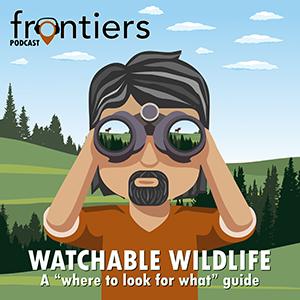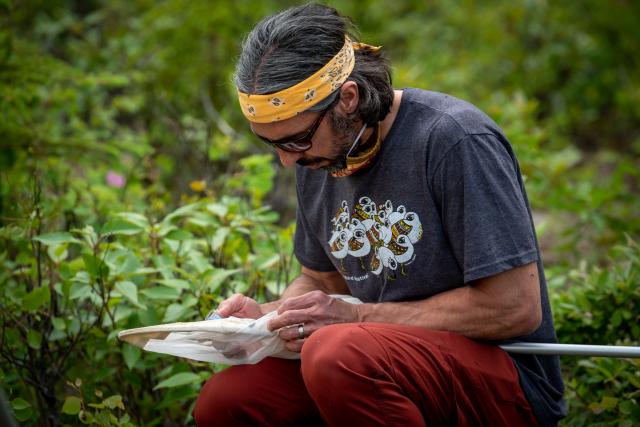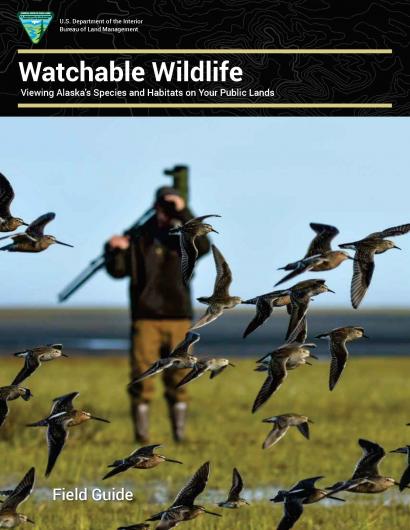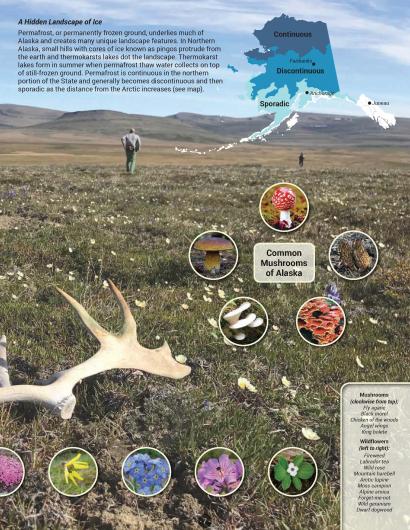You are viewing ARCHIVED content published online before January 20, 2025. Please note that this content is NOT UPDATED, and links may not work. Additionally, any previously issued diversity, equity, inclusion or gender-related guidance on this webpage should be considered rescinded. For current information, visit https://www.blm.gov/blog.
Podcast: Watchable Wildlife, a "where to look for what" guide

Transcript
[Jim Hart]: Welcome to the BLM Alaska Frontiers podcast. I'm Jim Hart.
Alaska is a great place to see wildlife, but where should you go? If you want to see a mountain goat or a Dall sheep, do they even live in the same habitat? Or how about a spectacled eider or bristle thighed curlew, those are birds, by the way.
Even the ground has plenty to see with boreal toads and wood frogs, mushrooms like black morels and chicken of the woods, and flowers like dwarf dogwood and Labrador tea.
If only there was a brochure to help sort all of this out, written by people who live and breathe wildlife. And there is. It's the BLM Alaska Watchable Wildlife brochure [downloadable PDF] available at BLM.gov/Alaska. Casey Burns is the Wildlife and Threatened and Endangered Species Program lead for BLM Alaska, and he's the co-author of the brochure.
Casey, welcome to Frontiers.
[Casey Burns]: Thanks, Jim. Happy to be here talking about watchable wildlife.
[Jim Hart]: Tell us a little bit about the duties you have as a wildlife program lead.
[Casey Burns]: My duties include coordinating BLM habitat management with our partners in the state, nationally and internationally. But what I really love is the diversity of my job. In any given day, I can be working on seals, caribou, bees, shorebirds, and a multitude of other species. I enjoy the practical challenges of the position managing habitat as part of a balanced, multiple use landscape.

[Jim Hart]: What made you decide to become a biologist?
[Casey Burns]: As far back as I can remember, I think like most kids, I was interested in nature and wildlife, and I think that's just natural. I grew up near the beach and I remember always taking a bag with me and just collecting shells and rocks and seaweed. And I've just been lucky, I guess, to have a passion from a young age and being able to focus and pursue that.
[Jim Hart]: So why does BLM make a watchable wildlife brochure?
[Casey Burns]: There's been a demand for this type of information. A lot of people come to Alaska and they want to see the wildlife. They come here for the nature. And the Bureau of Land Management has some of the best, most wild, abundant wildlife land in Alaska. We have a lot to offer and we want to share that with people. We want them to go out and recreate and enjoy watching wildlife responsibly and knowledgeably on BLM land.
[Jim Hart]: The all-inclusive master document has a total of 27 pages of information and is available online. How else is it going to be made available?
[Casey Burns]: It's going to be available as handouts for each location of the eight locations around the state, as well as summary information will be available. So, there's a table of contents. There's also a map so you can know where you're going to go and what information you can find for that area pretty quickly. We're trying to get people the information that they need for the site that they're going to or for the species that they're interested in.

So the master document, the full brochure will be available initially and then over time we'll be developing the components of the website of some standalone versions for each site and more bite sized digestible pieces for four individuals.
[Jim Hart]: Excellent. So, what are you hoping people get from the brochure?
[Casey Burns]: We want people not just to use it as a menu where they say, I want to see a caribou and I want to go here and stop on the road and see a caribou. You know, that's nice. And we all want to be able to do that quickly and easily. But we also want people to understand the habitat and the species and learn a little bit along the way, understand how to watch wildlife, understand what features on the landscape the wildlife are keying off of. So we're looking at as an educational tool as well as a recreational tool for folks.

[Jim Hart]: When it comes to wildlife viewing, what's the most exciting viewing available in Alaska?
[Casey Burns]: It depends on what you like. I certainly have places that I enjoy. And on [BLM-managed public lands], we can offer a lot of different areas in terms of habitats and species around the state. The accessibility varies quite a bit, too, from an easy visit in Anchorage to Campbell Track that you can drive and park and visit in an afternoon if you're interested to potentially planning a week long expedition into the remote areas of the National Petroleum Reserve.
There's really some interesting highlights from the Haines area starting down south, where we have temperate rainforest and a whole suite of species down there that aren't found in other parts of Alaska, versus maybe going up to the Fortymile region where you can see Dall sheep and caribou pretty common commonly in those areas as well as the Steese and White Mountains. If you want to go over to the Seward Peninsula, that's a great place to see muskox. There's an abundant salmon run in that area, and it's a hotspot for migratory birds in June, especially some unique, more Asian species that you could see in that area. And then again, the expedition to the National Petroleum Reserve, where there is no road system and you're flying in Bush planes to get out there and really having to be self-sufficient.
[Jim Hart]: So, did you guys include a couple of pages of information about the different species of mosquitoes that you'll find?
[Casey Burns]: You know, we do we do highlight invertebrates and we do talk about pollinators and mosquitoes and other flies are actually really important pollinators in Alaska. So, we try to look at the ecological value of all the species. And like you and most people, you know, I don't enjoy being swarmed by mosquitoes, but hopefully from a biological perspective, we can recognize that they are playing a role in the ecosystem. They're an important food source for many species. And really, the swarming mosquitoes and other bugs that we have in the late spring and summer time is what makes Alaska such a hotspot for migratory birds.
We have birds from all over the world that come to Alaska because of the space that we have and the abundance of food during that eruption of bugs that we have. So there is some good some silver lining to our mosquitoes and our other bugs that we have in the summertime here.
[Jim Hart]: So, are there other resources your team is working on?
[Casey Burns]: Yeah, we're always looking to do more outreach. And one of the things that I guess I'd like to share with folks is we're working a lot on pollinators, especially our native bees in Alaska. And we'll be doing some sessions at the Campbell Creek Science Center for the public to share information and potentially engage people in a citizen scientist program to help monitor our native bees in Alaska. So that's something you'll see coming up on the horizon in the next couple of months. So stay tuned for that [check out the CCSC website this spring and summer for schedules].
[Jim Hart]: Well, Casey, it sounds like you guys are busy, and the brochure is a great tool. Thanks for coming in and telling us about it.
[Casey Burns]: Thanks, Jim. Thanks for your interest in this. And if folks have any questions, you should be able to see this all on our website. And you can also contact us at BLM for more questions. So, I appreciate your interest, Jim, and everyone else out there.
[Jim Hart]: All right. Thanks, Casey.
[Casey Burns]: Thanks.
[Jim Hart]: That concludes this Frontier's podcast. Make sure you stop by and check out the BLM Alaska website and our Facebook page, or you read about all sorts of new things relating to your public lands in Alaska.
The Frontier As podcast is a production of the BLM Alaska Office of Communications.

James Hart, Public Affairs Specialist
Related Stories
Office
222 W 7th Avenue #13
Anchorage, AK 99513
United States
